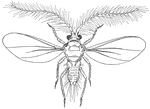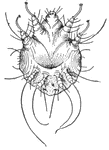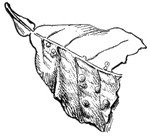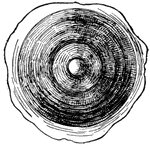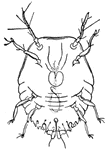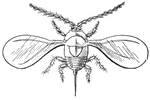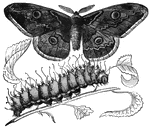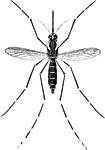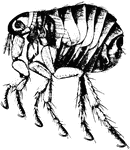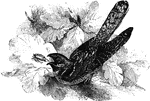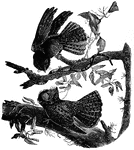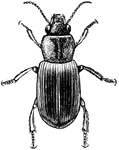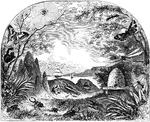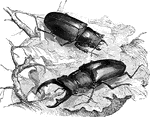
Walking Stick
Walking sticks lead a sluggish life among the branches of shrubs, living on the young shoots. Their…

Leaf Insect
Walking Sticks and Leaf Insects lead a sluggish life among the branches of shrubs, living on the young…
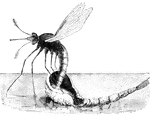
Mosquito
When the common mosquito is first hatched in the water it is called a wriggler. After developing to…
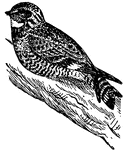
Nighthawk
An American insect-catching bird related to the whip-poor-will, a member of the goatsucker family.

Woodpecker
While a woodpecker is drilling, the two parts of the bill are closed together, making a wedge-pointed…
Smooth Caterpillar
The body is cylinder and divided by rings into thirteen segments. The smooth caterpillars don't have…

Hairy Caterpillar
Caterpillars are an insect that is cylinder and is divided by rings into 13 segments. The hairy caterpillar…
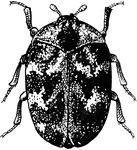
Adult Common Carpet Beetle
An adult common carpet beetle, a small grayish or black beetle belonging to the order Coleoptera.

Common Carpet Beetle Pupa
Pupa of the common carpet beetle, a small grayish or black beetle belonging to the order Coleoptera.

Common Carpet Beetle Larva
Larva of the common carpet beetle, a small grayish or black beetle belonging to the order Coleoptera.

Common Carpet Beetle Larva
Larva of the common carpet beetle, a small grayish or black beetle belonging to the order Coleoptera.

Whippoorwill
A whippoorwill chasing a winged insect. This bird derives its namesake from its distinctive call.
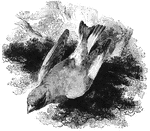
Green Grosbeak
Also known as the green finch, the green grosbeak frequents gardens, orchards, small woods, and cultivated…
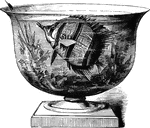
Copperband Butterflyfish
"It feeds upon insects, and is remarkable for its method of procuring them. When it observes a fly,…
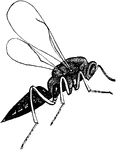
Abdomen
"The belly; that part of the body of a mammal which lies between the thorax and the pelvis; In entomology,…
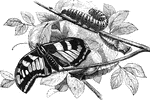
Stages of Development of a Butterfly
"Butterfly, Grub or Caterpillar, and Pupa or Chrysalis" — Goodrich, 1859
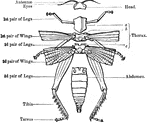
External Anatomy of an Insect Skeleton
"Anatomy of the external skeleton of an insect" — Goodrich, 1859
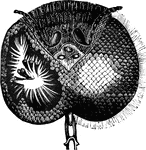
Eyes of a Bee
"The eyes, which are among the most wonderful objects in nature, are almost always of the kind called…

Mouth and Tongue of a Bee
"The structure of the mouth in insects exhibits very remarkable modifications, and these are of the…

Digestive Apparatus of an Insect
"a, head, antennae, &c; b, pharynx; c, crop; d, gizzard; e, chyle-forming stomach; f, biliary vessels;…

Tiger Beetle Larve
"The common European species, Cincindela campestris, may be found flying and running around…
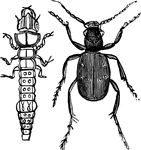
Tiger Beetle and Larvae
"The common European species, Cincindela campestris, may be found flying and running around…
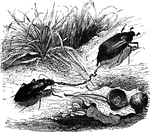
Golden Carabus and Cock-Chafer
"In illustration of the savageness of this race, the author of the "Jardin des Plantes" tells us of…
!["The Inquisitor Carabus, <em>C. inquisitor</em>, has the same form and manner as the [Sycophant Carabus]: the body is an inch long, and of a blackish-green color." — Goodrich, 1859](https://etc.usf.edu/clipart/14600/14649/inquiscarabs_14649_mth.gif)
Inquisitor Carabus
"The Inquisitor Carabus, C. inquisitor, has the same form and manner as the [Sycophant Carabus]:…
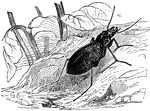
Blue Carabus
"The Blue Carabus, C. cyaneus, is an inch and a quarter long, the body oval, flat, and above…

Bombadier Beetle
"The bombadier beetle has a large oval abdomen, which secretes a caustic fluid. They live in societies,…

Great Diving Beetle Adult and Larvae
"The Dyticus marginalis, a European species very common in ponds, attains a length of more…

Great Diving Beetle Female
"The Dyticus marginalis, a European species very common in ponds, attains a length of more…

Cocktails
"The larvae are very similar to the perfect insects, both in appearance and habits. Many of them feed…
!["One of the largest European beetles, the Brown Hydrophile, <em>Hydrous piceus</em>, which is common in ponds in some localities, belongs to [the philhydrida]." — Goodrich, 1859](https://etc.usf.edu/clipart/14600/14660/brownhydro_14660_mth.gif)
Giant Silver Beetle
"One of the largest European beetles, the Brown Hydrophile, Hydrous piceus, which is common…

Lard Beetles
"Received its specific name on account of the fondness exhibited by its curious larva for bacon." —…
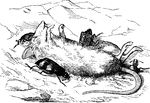
Burying Beetles
"The Burying Beetles are prompted by their insect to bury any small animals or pieces of carrion as…

Four-Spotted Beetle
"Smallish insects, generally of a black color, with the elytra rather shorter than the body, which is…

Scarab Beetle
"Is nearly twice as long as the hercules beetle, its color being of a brilliant brown." — Goodrich,…
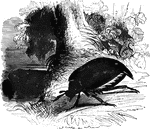
Cockchafer
"In the common European Cock-Chafer, Melolontha vulgaris, they are of considerable length,…

Sacred Beetle
"Many of the dung beetles, among which the Sacred Beetle of the Egyptians, Scarabus Aegyptiorum,…

